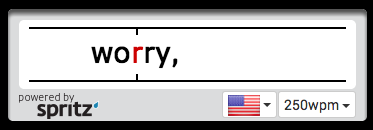Spritz, a Boston-based startup that’s been developing a speed-reading technology in stealth since 2011, is in the process of closing a $3.54 million seed funding round. Investors include Denis O’Brien, investing through his telco company Digicel.
$1 million of the seed was raised earlier, when the company was known as Spritz Technology LLC (it’s now Spritz Technology Inc), but the rest of the round — $2.54 million — is committed and due to be closed within a couple of weeks, TechCrunch has learned.
Spritz’s patent-pending technology streams text at readers, one speedy word at a time, to cut down the time the reader’s eye has to spend moving from word to word — letting them consume text more quickly (or that’s the theory).
To aid the reading process, Spritz aligns words using what it refers to as an “optimal recognition point method” which presents the portion of the word that apparently allows the reader to most quickly recognize it, so the next word can be speedily pushed out.
The focal point Spritz has identified for the eye to best parse words is where the letters coloured in red appear in the below examples:


To use Spritz, readers choose their word per minute rate, hit play and simply stare at the same spot where each single word appears, aligned for fast consumption.
Spritz says the technology can support variable speed reading rates of between 100 to 1,000 words per minute — albeit, at 1,000wpm you’re really going to feel like a robot. Blink and risk missing whole sentences.
The company is making grand claims about “reinventing the way people read”. But, as others have already noted, rapid serial visual presentation (RSVP) techniques date all the way back to the 1970s. And studies of RSVP speed-reading methods have indicated that comprehension and retention of data falls as speeds increase.
Despite this, Spritz argues that its take on speed reading is different. And, indeed, it rejects any similarities with “other RSVP-based software” — beyond the fact that both show users one word at a time — claiming its technology is based on a comprehensive re-analysis of how people read and comprehend text that’s also specifically tailored to consumption on mobile devices.
“Other than single word display, we are very different from anything else that’s been tried in the past and we think people can see that immediately,” says co-founder and CEO Frank Waldman. “Anyone who has tried Spritz knows how fast and easy it is to learn. There is nothing else out there that we have seen where most users can significantly improve their reading speed in less than five minutes.”
“Spritz is based on a complete and systematic re-analysis of the reading process,” he adds. “For the redesign and optimization components, we thought about all of the new possibilities that new digital devices and mobile capabilities create. When we started researching Spritz, there were many other (speed) reading techniques but they either relied on conventional (static) text representation on a printed page or they didn’t integrate well into the modern mobile landscape.”
Waldman also claims Spritz’s technology “promotes increased comprehension of the material versus traditional reading” — truly a grand claim, considering the history of RSVP. (I asked Spritz what studies it has done to back up its comprehension claims and will update this post with any response.)
“From our tests we have seen that many people can reach speeds around 600 wpm while still exhibiting high comprehension rates,” he says. “Every person we tested so far was able to read with Spritz. Some did stay on low speeds of 300wpm. But this is still faster than conventional reading speed. People only have to know that they have to focus on the red character and the hash marks. Then after 2-3 short texts they already start to relax as they understand that they can easily get the words without eye movement.”
Spritz is not making any apps itself, but is rather focusing on licensing its technology to others — to websites, device and app makers — to spread its reworked reading system further. Its business model is not cemented yet; it wants to get users first. Its ambition: one billion readers.
“At this time, Spritz is focused on building a user community of 1 billion readers,” says Waldman. “We want everyone to make their apps and webpages ‘Spritzable’.
“Our goal is ubiquity, we want to make sure that everything that makes sense to spritz can be spritzed. We are not just a consumer-play and expect to partner with large technology companies. For example: Google Mail can be powered by Spritz so users can easily open and read emails on the go. Google can also integrate Spritz into Google Maps so users can view comments, reviews, ads and promoted content from businesses. Companies like Amazon can also integrate Spritz into their e-readers. With Spritz, Yahoo! can let users easily find what they’re looking for without leaving their current web page.”
“We also hope that some of the bigger players in tech, most of whom we showed Spritz to last fall, will wish to partner with us instead of attempting to copy our technology, we have worked incredibly hard and almost everything that you see with Spritz is patent-pending,” he adds.
The startup publicly outted its technology earlier this month and has its first partners lined up to deploy it. The first implementations on mobile will be the email applications of the Samsung Gear 2 smartwatch, and the Galaxy S5 smartphone.
The smartwatch use-case — with its constrained screen size — has an obvious application for a technology that can break a large amount of tech down into consumable chunks. Albeit, users may not want to sit and stare at their wrists for very long periods.
“We believe that the best use cases for Spritz involve daily tasks that involve improving convenience and efficiency for our users,” adds Waldman. “We think that Spritz is wonderful for cutting through all of the things that you HAVE to get done during the day. A smartwatch running your email on Spritz is a great example.”
Another arguably more interesting potential use-case for Spritz could be low-cost feature phones which have small and low resolution screens — with the technology acting as an enabler for mobile users in emerging markets to comfortably access large amounts of information on budget devices.
“Our goal is to make Spritz available anywhere that our partners and their users think that it makes sense,” adds Waldman. “We expect a lot of innovation in the ways that partners integrate spritz technology into webpages and apps in all kinds of devices throughout the Internet of Things. You may see spritzing in all types of media, including broadcasts and movies. Billions of readers around the world could soon be spritzing as way to effortlessly consume information.”
TechCrunch’s Sarah Perez contributed to this report
